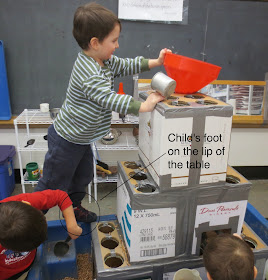Take for instance the latest box tower creation: The Step Box Tower.
Let's start with the floor
The floor---in this case, the bottom of the green pail---is the lowest level and a place to play.
Next is the bottom of the table.
This child is watching himself scoop pellets from the bottom of the table through one of the holes in the apparatus. You might say he has gained a unique perspective of that level.
Next is the level of the first step formed by the three bottom boxes.
Notice how this child is using the hole to stabilize his cup while he fills it on this level.
Next is the level of the second step formed by the two boxes set on top to of the bottom boxes.
This child is taking pellets from the funnel and throwing them in the window.
And finally, there is the top most level created by the top box.
What is important to note in this process of operating on all the different levels is that to continually work on higher levels, the children have to reach higher and higher. They often start by appropriating the stools that are always around the sensory table.
If they really want to see the top level, they will, in short order, climb up on the lip of the table to get a better view or better leverage.
Would you let a child climb on the lip of the table?
And sometimes the child actually climbs up onto the apparatus. As you can see in the picture below, the child is standing on one of the boxes that forms the base of the structure.
I think most teachers would have little trouble with the children who keep their feet on the floor or on those stools. How about those children, though, who want to go higher? Is it OK to climb on the lip of the table or the apparatus itself? Is it even safe?
I do not always know the answer. Some of it depends on the child and how comfortable and stable he is with climbing. What I do know is that if the apparatus has a vertical orientation, the children will want to challenge themselves every time with vertical endeavors.
Here's are a couple of questions for you. In what ways do you see children in the classroom show a need to reach and climb? What sorts of outlets are there in the classroom for them to do so?
There is one final note: If you have loose parts, the highest level the children reach can be higher than the top of the apparatus.










I LOVE this and will for sure be seen in my classroom next week. My classroom is a level place and will add a new interest to my sensory table
ReplyDeleteThanks Angelina. I start with a low table and build up and inevitably the children want to explore all the spaces and levels. Let me know how it goes and send a picture.
DeleteTom,
DeleteI have been reading your posts for about three years now, and just want to thank you for sharing your ideas and insights. I always learn something interesting. As well I enjoy your philosophy of the classroom as a reciprocal place. That is what I too believe, and it is heartening to see you describe this kind of learning environment so well.
I too want to do box towers, and have in the past used ramps, and tubes after reading here.
Brenda
Thanks Brenda for your kind words. I am at a point in my teaching career where most of my work is done before the children come into my classroom. That allows me the time to step back and observe---and learn from the children how they learn.
Delete